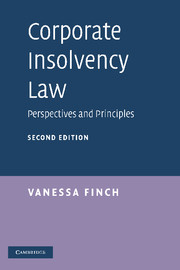Book contents
- Frontmatter
- Contents
- Acknowledgements
- Table of cases
- Table of statutes and other instruments
- List of abbreviations
- Introduction to the second edition
- PART I Agendas and objectives
- PART II The context of corporate insolvency law: financial and institutional
- PART III The quest for turnaround
- PART IV Gathering and distributing the assets
- 13 Gathering the assets: the role of liquidation
- 14 The pari passu principle
- 15 Bypassing pari passu
- PART V The impact of corporate insolvency
- 18 Conclusion
- Bibliography
- Index
13 - Gathering the assets: the role of liquidation
Published online by Cambridge University Press: 05 June 2012
- Frontmatter
- Contents
- Acknowledgements
- Table of cases
- Table of statutes and other instruments
- List of abbreviations
- Introduction to the second edition
- PART I Agendas and objectives
- PART II The context of corporate insolvency law: financial and institutional
- PART III The quest for turnaround
- PART IV Gathering and distributing the assets
- 13 Gathering the assets: the role of liquidation
- 14 The pari passu principle
- 15 Bypassing pari passu
- PART V The impact of corporate insolvency
- 18 Conclusion
- Bibliography
- Index
Summary
Liquidation is the end of the road for the troubled company. It involves its winding up and the gathering in of the assets for subsequent distribution to creditors. On the commencement of liquidation the principle of collectivity takes effect and this is reflected in a moratorium on hostile actions and the restraining of uncompleted executions. Liquidation, nevertheless, raises issues of efficiency, expertise, accountability and fairness as much as processes involving prospects of rescue. This chapter explores those issues as well as the conceptual underpinnings of liquidation. Liquidations are encountered in three main forms: voluntary, compulsory and public interest, and to set the scene, it is necessary to review the varieties of liquidation and the legal framework that supports the liquidation process.
The voluntary liquidation process
A voluntary liquidation of a solvent company is termed ‘a members’ voluntary winding up' and, where an insolvent company is involved, this is then known as ‘a creditors’ voluntary winding up'. This distinction flows from the Insolvency Act 1986 sections 89 and 90 which provide that if the directors have made a statutory declaration of solvency under section 89, a members' voluntary liquidation occurs, but that the liquidation is a creditors' voluntary liquidation in the absence of such a declaration.
Both types of voluntary liquidation are, however, triggered by the actions of the company's members. These members can initiate a winding up by passing a special resolution in favour of a voluntary liquidation.
- Type
- Chapter
- Information
- Corporate Insolvency LawPerspectives and Principles, pp. 529 - 598Publisher: Cambridge University PressPrint publication year: 2009



